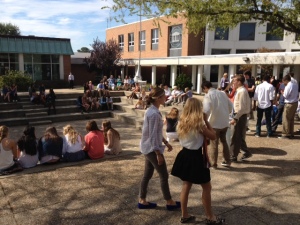Some large independent schools are the size and complexity of a small school district and often describe themselves as a Titanic when it comes to changing course from successful traditions to a more innovative future. But we have seen that many are indeed changing, with fascinating nodes of intense creativity. Innovation takes time, but the face of learning is already substantially changed from just a few years ago. This post is about how a mission of “judicious experimentation” has brought about a bold new leadership program, a roiling pot of Middle School innovation in math and technology, and a heart-warming deep dive of community reflection.
 Norfolk Academy is a large, old preK-12 school drawing students from all over the Hampton Roads/Norfolk region. Head Dennis Manning said they don’t believe in following the latest fads in education, but have intentionally placed the value of “judicious experimentation” squarely in their mission statement, and I heard it quoted repeatedly during the day. “I’m a free market headmaster; I want to spark brushfires. We built an educational grant program which has driven innovation faster than anything I could have imagined.” He said they are focusing on three strands of such experimentation: technology, leadership, and summer faculty PD program which pays teachers to design and write new curriculum. He also said that the most productive PD he has seen is when they have sent entire grade level groups out to other schools to get a deeper understanding and exposure to what is possible from people with different viewpoints on how learning takes place.
Norfolk Academy is a large, old preK-12 school drawing students from all over the Hampton Roads/Norfolk region. Head Dennis Manning said they don’t believe in following the latest fads in education, but have intentionally placed the value of “judicious experimentation” squarely in their mission statement, and I heard it quoted repeatedly during the day. “I’m a free market headmaster; I want to spark brushfires. We built an educational grant program which has driven innovation faster than anything I could have imagined.” He said they are focusing on three strands of such experimentation: technology, leadership, and summer faculty PD program which pays teachers to design and write new curriculum. He also said that the most productive PD he has seen is when they have sent entire grade level groups out to other schools to get a deeper understanding and exposure to what is possible from people with different viewpoints on how learning takes place.
The Norfolk Center for Civic and Global Leadership was created out of the recognition that 60% of Norfolk graduates return to this region, and many go on to become involved in civic leadership. NA felt a commitment to leadership development training, to “help prepare these students to get off the sidelines and into the game” in whatever future they choose. “This is about enhancing our community.” The program was started with a major grant from the E.E. Ford Foundation and the leaders say that they are “building the airplane in the air”. (How many times have I heard that phrase in the last seven weeks?) It is a four-year program for which students must apply in 8th grade. Only about 25% are selected for the program, and the school believes it is OK for students at that age to hear “no” even when they are interested and qualified for acceptance. The program requires students to make a major choice and commitment; they don’t get extra credit and they put in a great deal of time.
There are currently three tracks in the Center, themes that take on “some of the truly intractable problems of our time that these students will be dealing with during their lives.” The current tracks involve saving Chesapeake Bay, international issues of peace and justice, and global health. The work involves reading and research that the participants integrate back into their regular classes; summer trips to tackle problems in the field; and leadership training programs. Each of the four years has a broad theme that ties together the work in which the students engage:
- 9th grade Themselves
- 10th grade Team
- 11th grade Effecting change
- 12th grade Mentoring others
NA did not view this program as a big risk, and they are watching as the impacts ripple through the faculty and the community. They plan to add two more major tracks. They are thinking of how to allow more students to participate and how to percolate the lessons they are learning in interdisciplinary and thematic learning across the regular curriculum. The greater Norfolk community is starting to see the Center as a focal point of the Academy, which adds value to the school in the eyes of the community.
On the wall of a 9th grade biology class I saw a reminder sign posted on the wall that I have never seen in a school before: “You will need your cell phone today”. I met with a biology teacher, three math teachers, and sat in on two classes, and the only way I can relay the non-linear explosion of innovation is with bullet points:
- One teacher uses Celly to broadcast texts to his students, take polls in class, and use as a community whiteboard.
- They carpeted a room and bought desk/chair units with rolling castors, so the students are constantly grouping and re-forming to work problems together and apart in a large-scale Brownian motion of collaboration.
- Students work problems on the walls, solving proofs together and “defending their white boards”.
- The iPad pilot is going superbly; students in biology said they really do learn more deeply when they can cycle back through their electronic textbook, go off to linked media, and quickly check the meaning of words they don’t know.
- A teacher told the students working in groups to “keep your pencils off your papers as long as possible. Talk!”
- The teachers built their own workbook with a set number of math problems each day; the new “textbook” costs $6.
- They use some Khan Academy; they are piloting some video podcasts; they lecture when needed.
 As if all of that is not enough, here is a real kicker: students can come to any class in the subject level and slot right in. Because the school has a large community service component, students may be off campus or otherwise engaged during their normal class time. No problem. Each class in a subject is doing the same problem set as the backbone of the class, so students can drop in on any teacher or any class at any time. All of the math teachers in a grade level contribute to assessment of each student. “What we found is that you can actually teach geometry in about 6 weeks if you have to. The rest of the time we are engaging the students in projects that actually use math in ways that interest them. They have designed a locker room. They designed new athletic shoes all the way from how to make them to getting sponsors, and all that uses math.”
As if all of that is not enough, here is a real kicker: students can come to any class in the subject level and slot right in. Because the school has a large community service component, students may be off campus or otherwise engaged during their normal class time. No problem. Each class in a subject is doing the same problem set as the backbone of the class, so students can drop in on any teacher or any class at any time. All of the math teachers in a grade level contribute to assessment of each student. “What we found is that you can actually teach geometry in about 6 weeks if you have to. The rest of the time we are engaging the students in projects that actually use math in ways that interest them. They have designed a locker room. They designed new athletic shoes all the way from how to make them to getting sponsors, and all that uses math.”
“The students have to play with what is going on to be successful. We are not going to hand it to them. At first they whine because they expect the teacher to tell them how to do a problem and then just reproduce it. We don’t do that. We are comfortable with making the kids uncomfortable. We solve the most difficult problems in class and they work on the easier ones at home so the students build confidence.” “We share, we teach multiple levels, and we have to surrender our own egos to the team, just as students sometimes do. This is not ‘my class’; it is ‘our class’”. How many silos have been busted by this inspiring group of teachers? Just about all of them: time, subject, and classroom space.
 The other program I wanted to share (many more, but my brain’s bandwidth is getting slammed) is a beautiful all-school combination of theme, reflection, conversation, viewpoint, mentoring, and sharing. Once a year, NA holds a daylong, all-school event. They break up into about 50 groups that mix grades 1-12 and faculty, and all read the same book. Of course, these are children’s books, but one that is meaningful for adults as well, as of course so many are. The day starts with a communal reading of the book, and a homegrown interpretive dance of the story. Then they divide up into their groups and spend the day in conversation related to the themes and messages of the book. The overall goal is an “all-school exercise of the mind” (I LOVE that image) that creates “a really charming little red school-house feeling”. It is a marvelous deep dive, and perhaps the best example I have found on my journey of a direct stab at this self-created monster, False Dichotomy, between rigor and the time to be expansive.
The other program I wanted to share (many more, but my brain’s bandwidth is getting slammed) is a beautiful all-school combination of theme, reflection, conversation, viewpoint, mentoring, and sharing. Once a year, NA holds a daylong, all-school event. They break up into about 50 groups that mix grades 1-12 and faculty, and all read the same book. Of course, these are children’s books, but one that is meaningful for adults as well, as of course so many are. The day starts with a communal reading of the book, and a homegrown interpretive dance of the story. Then they divide up into their groups and spend the day in conversation related to the themes and messages of the book. The overall goal is an “all-school exercise of the mind” (I LOVE that image) that creates “a really charming little red school-house feeling”. It is a marvelous deep dive, and perhaps the best example I have found on my journey of a direct stab at this self-created monster, False Dichotomy, between rigor and the time to be expansive.
At some point during the day, Assistant Head (and my patient handler for the day) Jay Rainey, asked two related and critical rhetorical questions: “Are schools essentially conservative or disruptive? Do schools exist to create the next entrepreneur or do those emerge despite schools?” What NA is doing so well through their mission-driven, explicit, intentional empowerment of judicious experimentation is to explore those questions, not in theory but in practice. In my view they are building their answer and the answer is that we are obligated to be at least somewhat disruptive, as that is the nature of the world in which we live.


Leave A Comment